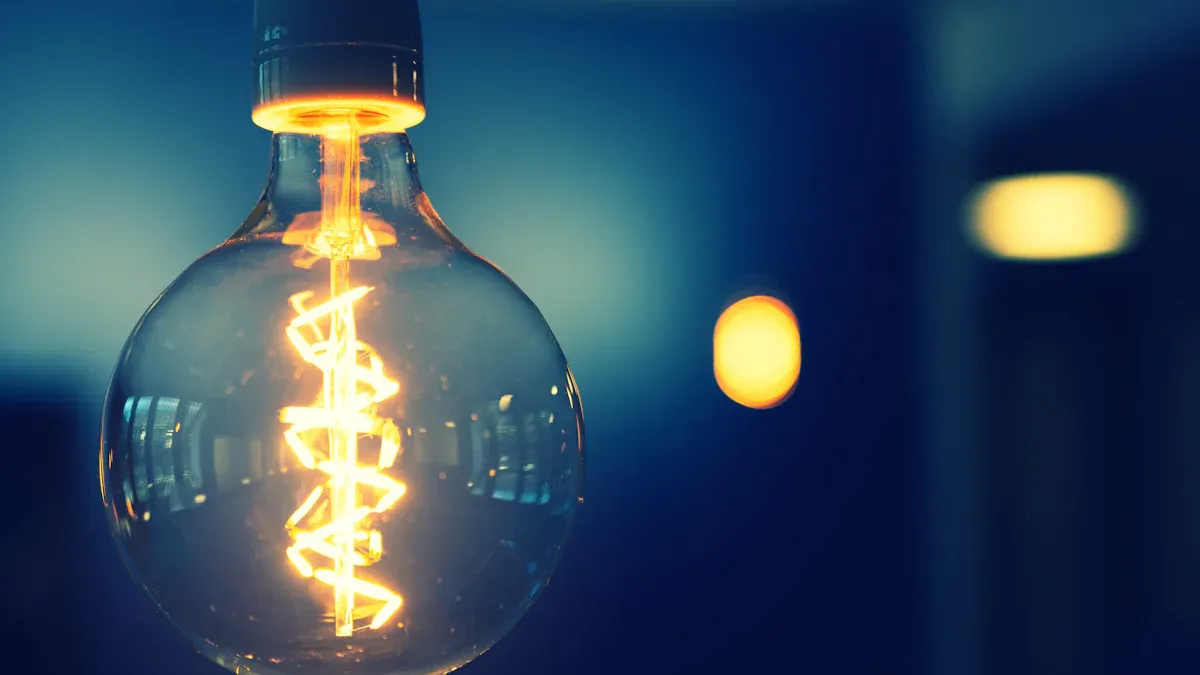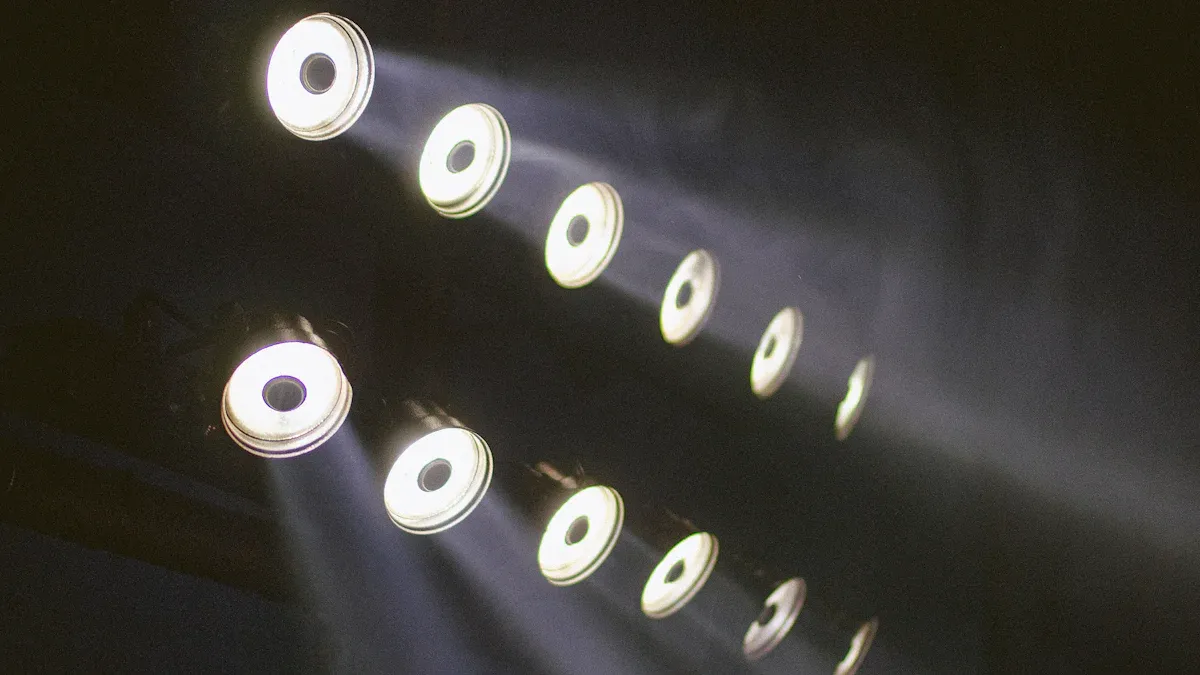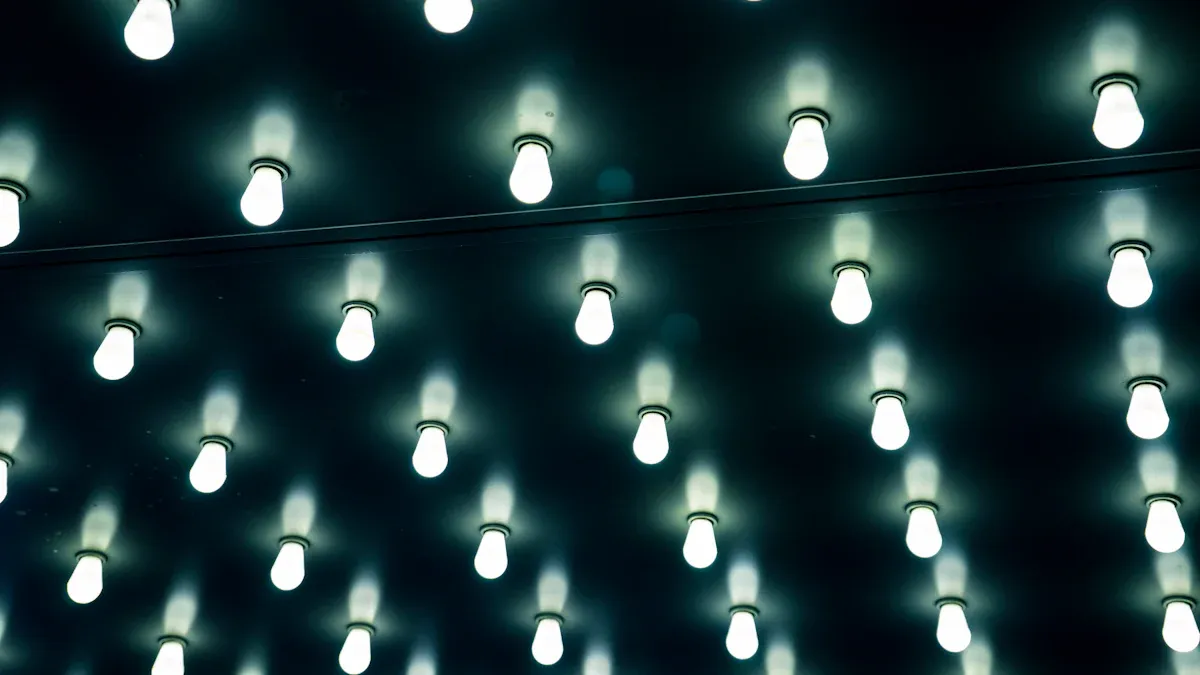LED Replacement Lights: Types, Benefits, and Installation

LED replacement lights have revolutionized the way we illuminate our spaces today. They provide brighter light while saving more energy. In homes, 47.6% of lights are now LED lights, and in businesses, the number is similarly high at 47.3%. This trend indicates that people are increasingly opting for eco-friendly choices. LED lights consume 75% less energy than traditional bulbs and last 25 times longer. Whether you need a camping light or a garden light, LED lights perform exceptionally well. They are durable, efficient, and environmentally friendly, making them ideal for all your lighting needs.
Key Takeaways
LED lights use 75% less energy than regular bulbs. This helps lower your electricity bills and saves money over time.
LEDs last much longer than old bulbs. They can work for 25,000 to 200,000 hours. This means you won’t need to replace them often.
Using LED lights is good for the planet. They produce less carbon and don’t have harmful stuff like mercury. This makes them safer for the environment.
LED lights come in many types, like bulbs, tubes, and fixtures. Pick the type that fits your lighting needs for the best results.
You can install LED lights yourself, but tricky setups may need a pro. This keeps things safe and ensures they are installed correctly.
Types of LED Replacement Lights

LED replacement lights come in many forms. Each type is made for specific uses in homes or businesses. Knowing these types helps you pick the best lighting for your needs.
LED Bulbs
Standard Bulbs
Standard LED bulbs are the most used type. They replace old incandescent or compact fluorescent bulbs. These bulbs fit most fixtures and save energy well. For instance, LED bulbs use 75% less energy than incandescent ones. They also last 25 times longer, saving you money over time.
Smart Bulbs
Smart LED bulbs offer advanced features. You can adjust brightness, color, and schedules using a phone app or voice assistant. These bulbs are great for creating custom lighting in homes or offices. They also work with dimming and motion sensors, helping save even more energy.
LED Fluorescent Replacement Tubes
T8 Tubes
T8 LED tubes are a top choice to replace fluorescent lights. They are 44% more energy-efficient than T8 fluorescent lamps. These tubes work well in offices, schools, and other workspaces.
T5 Tubes
T5 LED tubes are thinner than T8 tubes but save energy too. They are used in tight spaces needing high performance. Both T8 and T5 tubes last longer than fluorescent lights, cutting down on maintenance costs.
LED Fixtures
Recessed Fixtures
Recessed LED fixtures are built into ceilings for a clean look. They are often used in kitchens, living rooms, and offices. These fixtures are bright and energy-saving, making them a favorite for homes and businesses.
Panel Lights
LED panel lights are made for big areas needing even lighting. They work well in conference rooms or stores. These lights are efficient and spread light evenly. You can also upgrade old fixtures with LED retrofits easily.
Tip: Check the bulb base type of LED fixtures. This ensures they fit your current setup.
LED High Bay and Specialty Lights
LED high bay and specialty lights are made for tall spaces. They give strong light, perfect for factories or big buildings.
High Bay Lights
High bay lights are used in places with ceilings over 20 feet. They shine bright light to help people see in large areas. Warehouses, gyms, and factories use these lights for safety and work. They come in different shapes like round, linear, and UFO styles.
The need for LED high bay lights is growing fast. In 2023, the market was worth about $5.2 billion. By 2032, it may grow to $9.8 billion, increasing by 7.2% each year. These lights save energy and last longer, which helps the planet. They also lower carbon emissions by using less power.
When picking high bay lights, think about your ceiling height. Choose a fixture that fits your space. LED high bay lights work well in stores, factories, and other big places. They stay bright for a long time and need less fixing.
Strip and Decorative Lights
Strip and decorative lights make spaces look nice and bright. LED strip lights bend easily and can go under cabinets or along walls. They are great for adding mood lighting in homes, shops, or restaurants.
Decorative LED lights, like string lights, make areas look pretty. They save energy and come in many colors and styles. Use them to highlight features or create a warm feeling. These lights give you many creative options.
Note: Always check your LED light details to match your needs. Install and care for them properly to make them last longer.
Benefits of LED Replacement Lights
Energy Efficiency
Using less energy
LED lights use much less energy than old bulbs. They save up to 75% compared to incandescent bulbs and are 44% better than fluorescent tubes. This makes them a smart choice for homes and businesses. For example, one city saved $9 million yearly by switching to LEDs, cutting energy use by 63%.
Lighting Type | Energy Savings |
|---|---|
LED vs. Fluorescent | 44% more efficient |
LED vs. Incandescent | 75% less energy used |
Lower power bills
LED lights help lower your electricity costs. In factories or big buildings, lighting can cost a lot. Switching to LEDs saves money over time. A study at the University of Michigan showed that LEDs cut energy use and reduce costs, making them a great long-term choice.
Longevity
Lasts longer
LED lights last much longer than older bulbs. Incandescent bulbs work for about 1,200 hours, but LEDs can last 25,000 to 200,000 hours. This means fewer replacements, saving you time and effort.
Lighting Type | Lifespan (Hours) |
|---|---|
Incandescent | 1,200 |
Fluorescent | 24,000-36,000 |
LED | 25,000-200,000 |
Less maintenance
LEDs are strong and need fewer repairs or replacements. This lowers maintenance costs over time. For instance, a city saved $2.5 million each year on repairs after switching to LEDs. This makes them a smart and reliable lighting option.
Environmental Impact
Better for the planet
LED lights are made to be eco-friendly. They use less energy, which lowers carbon emissions. A 60-watt incandescent bulb needs 60 watts, but an LED only uses 12.5 watts for the same brightness. LEDs are also recyclable, unlike fluorescent bulbs that have harmful mercury.
Lighting Type | Energy Use (Watts) | Environmental Effect |
|---|---|---|
Incandescent Bulb | 60 | High CO2, harmful materials |
Compact Fluorescent | 15 | Moderate CO2, contains mercury |
LED | 12.5 | Low CO2, fully recyclable |
No mercury, safe disposal
LEDs don’t have mercury, so they’re safer to throw away. By using LEDs, you help keep the environment clean. Studies show LEDs could save enough energy to power seven million homes for a year by 2030. This proves how good LEDs are for the planet.
Enhanced Lighting Quality
Bright and clear lighting
LED lights shine brightly, making them great for any room. Unlike old bulbs, they give steady light without flickering. This helps reduce eye strain, especially in places like offices or study areas. LED lights improve visibility and make spaces feel warm and inviting.
Another big advantage is their ability to show colors well. LED lights display colors just like natural sunlight. This is helpful in art studios, stores, or kitchens where true colors are important. With a high color rendering index (CRI), LED lights make everything look clear and colorful.
Tip: Choose LED lights with a CRI of 80 or more for better color accuracy.
Flexible choices
LED lights come in many styles, shapes, and sizes. You can pick the perfect one for your needs. Whether you need bright light for work or soft light for relaxing, LED lights can do both.
Some LED lights let you adjust brightness and color settings. This helps you create the right mood for any moment. For example, use warm light for a calm evening or cool light for working. Some even have smart features, so you can control them with apps or voice commands.
LED lights are very versatile, making them popular for homes and businesses. They not only improve lighting but also add a modern touch to your space.
Note: Check the details of LED lights to match your needs and preferences.
How to Install LED Replacement Lights

Putting up LED light fixtures might seem hard, but it’s doable. With the right tools and steps, you can finish it easily. This guide will show you the tools, steps, and safety tips for a smooth setup.
Tools and Materials
Tools you’ll need
Get all the tools ready before starting. You’ll need a screwdriver, wire stripper, voltage tester, and maybe a ladder for tall ceilings. These tools make the job safer and easier.
Picking the right LED lights
Choose the correct LED light fixtures for your space. Think about the size, brightness, and type of light you want. For example, recessed lights are great for kitchens, while panel lights fit offices. Make sure the LED matches your current setup to avoid problems.
Step-by-Step Installation
Getting the area ready
Turn off the power where you’ll work. Use a voltage tester to check there’s no electricity. Carefully take out the old fixture and disconnect the wires. Clean the spot to get it ready for the new LED light fixture.
Setting up and testing the LED light
Attach the wires of the new LED to the matching wires in the ceiling or wall. Secure the fixture with screws and make sure it’s steady. Turn the power back on and test the light. If it doesn’t work, check the connections again.
Safety Tips
Follow the instructions
Always read the manufacturer’s guide before starting. It tells you the exact steps for your LED light fixtures.
Be careful with wires
Don’t touch live wires. Use insulated tools and wear gloves to stay safe. If you’re unsure, ask a professional for help.
Tip: For high ceilings or tricky setups, hiring an electrician can save time and keep you safe.
Professional Installation
When to hire an electrician
Some LED projects might need expert help. You should hire an electrician for tricky setups or very high ceilings. For instance, putting up LED high bay lights in gyms or warehouses often means working at tall heights. This can be dangerous without proper tools or skills.
If you don’t know much about wiring, it’s better to call a professional. Wrong wiring can cause short circuits or damage your LED fixtures. Electricians are trained to do the job safely and correctly. They also make sure everything follows safety rules.
Another reason to get an electrician is when upgrading old systems. Older buildings might have outdated wiring that needs fixing to work with modern LED lights. A professional can check the wiring and make the needed changes.
Tip: Always look at the electrician’s reviews and credentials before hiring. This helps you find someone trustworthy.
Advantages of professional services
Hiring professionals has many benefits. First, it saves time. Electricians can finish the job fast, even for hard setups like high bay lights. You can focus on other things while they handle the work.
Second, they make sure everything is safe. Professionals follow strict safety rules to avoid electrical dangers. This is very important for risky jobs, like in factories or big commercial spaces.
Third, experts ensure quality. They have the right tools and skills to install LED lights properly. This lowers the chance of problems like flickering or uneven light later.
Lastly, professional services often come with warranties. If something goes wrong after the job, they’ll fix it. This gives you peace of mind and keeps your LED lights working well.
Note: While hiring an electrician may cost more at first, it can save money later by avoiding expensive mistakes.
LED replacement lights come in many types for different needs. These include bulbs, tubes, fixtures, and specialty lights. They save energy, last long, and are good for the planet. Installing them is easy, whether you do it yourself or get help. Switching to LEDs lowers energy use, cuts costs, and helps the environment. Check out the LED options today to brighten your space. The right LED lights can improve your home or business greatly.
FAQ
Why are LED lights better than old bulbs?
LED lights use less energy and last longer than old bulbs. They shine brighter and don’t flicker like fluorescent bulbs. LEDs are safer for the planet because they don’t have mercury.
Can LED tubes replace fluorescent ones easily?
Some LED tubes can replace fluorescent ones directly. Others need rewiring first. Always read the instructions to check if they fit your fixtures.
How do you pick the best LED light?
Think about brightness, color, and size when choosing LEDs. Warm lights are good for relaxing, while cool lights work well for tasks. Make sure the bulb fits your fixture.
Are LED lights okay for closed fixtures?
Not all LEDs work in closed fixtures. Check the label to see if they’re safe for enclosed spaces. Using the wrong type can make them overheat and wear out faster.
Do LED lights work with dimmer switches?
Some LED lights work with dimmer switches, but not all. Look for "dimmable" bulbs and make sure your dimmer switch supports LEDs for smooth dimming.
See Also
Understanding GE LED Bulbs: Key Features And Benefits
Selecting Dependable Solar Lights For Your Outdoor Spaces In 2025
